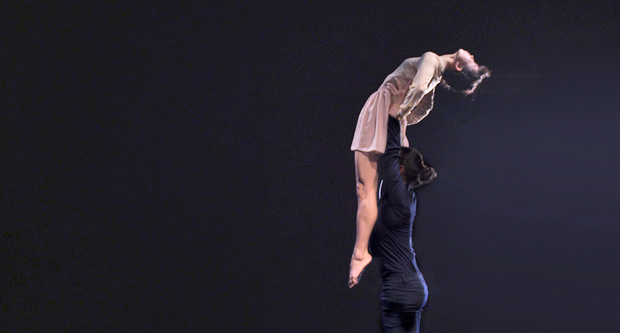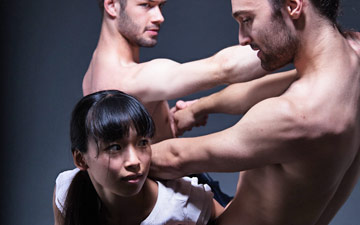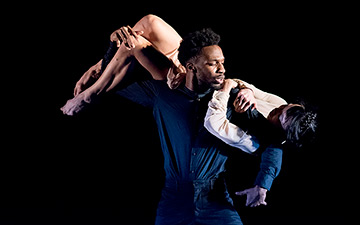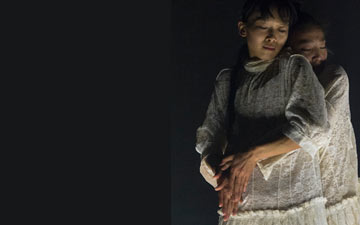
© David Foulkes. (Click image for larger version)
James Cousins Company
Without Stars, There We Have Been
London, The Place
20 October 2015
www.jamescousinscompany.com
www.theplace.org.uk
It was eleven months, minus a day, since I had first seen this powerful, absorbing double-header by James Cousins. Both works are loosely based upon Haruki Murakami’s 30 year-old novel, Norwegian Wood; although perhaps more appropriately, they are an evocation of its themes of friendship, love and loss rather than any attempt at a literal representation of the narrative In any event, none of the performers are labelled with the names of Murakami’s characters but the viewer is left able to assemble the action to fit any number of the novel’s scenarios. Or, perhaps more fittingly, to ignore that story altogether.
Without Stars plays with ideas of memory, loyalty and lost passion within a framework of melancholic nostalgia, significantly heightened by the atmospheric lighting designs of Guy Hoare. It seems to me that – while the structure appears the same – the detail of the choreography may have changed somewhat from eleven months’ ago. Cousins take the performers through many moods; some dances require close personal contact while in others, the prevailing action was for their bodies to rotate, roll, stretch and arc around each other, almost as if repelled into non-contact improvisation by some magnetic force.

© David Foulkes. (Click image for larger version)
In one duet, a third dancer, Georges Hann – a shadowy figure throughout – patrolled around the edge of the performance area, as if a referee at a boxing match. Although, the dancers’ movement seemed more at the edge of cool capoeira than old-fashioned pugilism. A long, grappling and sweaty male duet for Gareth Mole and Albert Garcia was followed by a solo for an emotionally expressive Chihiro Kawasaki, who must surely be Murakami’s fragile heroine, Naoko. Themes of sexual awakening, loneliness and loss were also reflected by the breaks in the dance action, including welcome moments of stillness when, for example, Mole sat on the floor, smoking a cigarette.
Norwegian Wood unravels in the memories of its middle-aged narrator, Toru Watanabe, casting his mind back, twenty years, to the 1960s – the trigger being the eponymous Beatles’ song – and his friendship with two young students (Naoko and Kizuki) both of whom take their own lives, some years apart. A platform for this nostalgic resonance is firmly set by opening with the Mills Brothers’ 40s song You Always Hurt the Ones You Love (repeated again towards the end). Henry Mancini’s classic Dear Heart was another key part of Seymour Milton’s diverse and emotive sound design, mixing these vintage songs with piano, strings, muffled rock and electronica.

© David Foulkes. (Click image for larger version)
The opening of There We Have Been has a stunning impact with Kawasaki, standing upright like an angel, lit from the knees up in an otherwise black space, several feet above the stage. She is held aloft by Hann – initially unseen in the darkness – and then he prevents her from touching the stage throughout the 17-minute duration of the duet. Cousins exhausts every possible style of lift and hold and there is only the merest hint of the hem of her skirt brushing the floor as Kawasaki is held in clinches, perches on Hann’s shoulders, stands on his legs and is held, horizontally-balanced, as if a giant cigar being rolled across his thighs.
A gentle and sophisticated elegance infuses their apparently effortless partnering and belies the considerable physical strength that must be required from both dancers. When Hann walks away from Kawasaki in the concluding moments, it may represent Watanabe finally breaking free from the spirit of Naoko; as her angelic vision remains high in the air (Kawasaki is again lit only from the hips up, while being held aloft by other unseen hands). It is a suitably memorable finale to end a duet of great impact.
Cousins has taken Murakami’s narrative and expertly blended and distilled just the essence of it into fascinating dance theatre that is very clearly stamped with his own highly original brand. I’m looking forward to more.

















You must be logged in to post a comment.